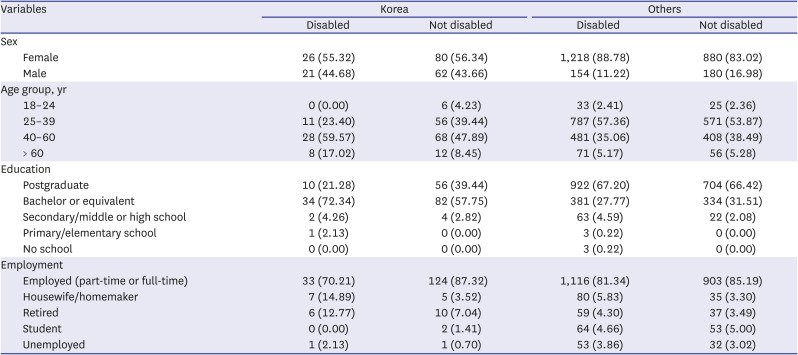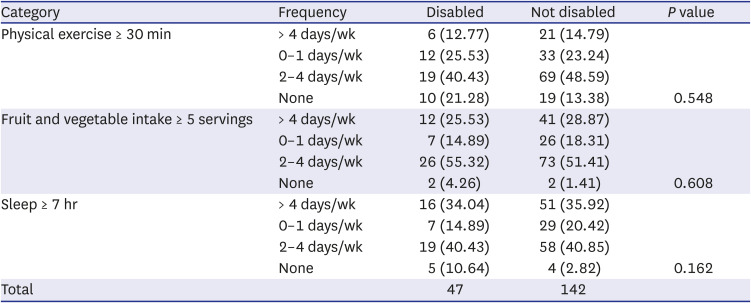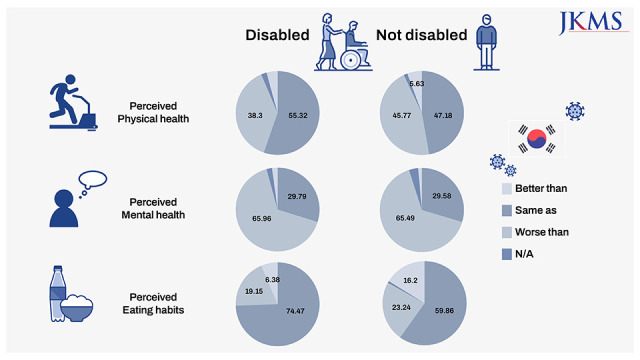1. Pears M, Kola-Palmer S, De Azevedo LB. The impact of sitting time and physical activity on mental health during COVID-19 lockdown. Sport Sci Health. 2022; 18:179–191.
2. Pancani L, Marinucci M, Aureli N, Riva P. Forced social isolation and mental health: a study on 1,006 Italians under COVID-19 lockdown. Front Psychol. 2021; 12:663799. PMID:
34093358.
3. Lee EPX, Man REK, Gan TLA, Fenwick EK, Aravindhan A, Ho KC, et al. The longitudinal psychological, physical activity, and financial impact of a COVID-19 lockdown on older adults in Singapore: the PIONEER-COVID population-based study. Int J Geriatr Psychiatry. Forthcoming. 2021; DOI: 10.1002/gps.5645.
4. Abate Daga F, Agostino S, Peretti S, Beratto L. The impact of physical activity rate on subjective well-being among North-Western Italian population during COVID-19 nationwide lockdown. J Sports Med Phys Fitness. Forthcoming. 2021; DOI:
10.23736/S0022-4707.21.12787-2.
5. Hwang TJ, Rabheru K, Peisah C, Reichman W, Ikeda M. Loneliness and social isolation during the COVID-19 pandemic. Int Psychogeriatr. 2020; 32(10):1217–1220. PMID:
32450943.
6. Hu Z, Lin X, Chiwanda Kaminga A, Xu H. Impact of the COVID-19 epidemic on lifestyle behaviors and their association with subjective well-being among the general population in Mainland China: cross-sectional study. J Med Internet Res. 2020; 22(8):e21176. PMID:
32759103.
7. Kim SJ, Lee S, Han H, Jung J, Yang SJ, Shin Y. Parental mental health and children’s behaviors and media usage during COVID-19-related school closures. J Korean Med Sci. 2021; 36(25):e184. PMID:
34184439.
8. Theis N, Campbell N, De Leeuw J, Owen M, Schenke KC. The effects of COVID-19 restrictions on physical activity and mental health of children and young adults with physical and/or intellectual disabilities. Disabil Health J. 2021; 14(3):101064. PMID:
33549499.
9. Senjam SS. Impact of COVID-19 pandemic on people living with visual disability. Indian J Ophthalmol. 2020; 68(7):1367–1370. PMID:
32587166.
10. Lund EM, Forber-Pratt AJ, Wilson C, Mona LR. The COVID-19 pandemic, stress, and trauma in the disability community: a call to action. Rehabil Psychol. 2020; 65(4):313–322. PMID:
33119381.
11. U.S. Food & Drug Administration. South Korea's Response to COVID-19. Silver Spring, MD, USA: U.S. Food & Drug Administration;2021.
12. Sridhar D. What the UK Can Learn from South Korea’s COVID Response. London, UK: The Guardian;2021.
13. Jang W, Kim B, Kim ES, Song KH, Moon SM, Lee MJ, et al. Are the current guidelines sufficient to establish infection control strategies for COVID-19 related issues in hospitals? J Korean Med Sci. 2021; 36(50):e343. PMID:
34962115.
14. Yun KW, Kim KM, Kim YK, Kim MS, Kwon H, Han MS, et al. Limited benefit of facility isolation and the rationale for home care in children with mild COVID-19. J Korean Med Sci. 2021; 36(5):e45. PMID:
33527787.
15. Kim JM, Yoo JH, Cho HK, Hong ST. Analysis of PubMed and KoreaMed indexed Korean publications on COVID-19. J Korean Med Sci. 2021; 36(49):e345. PMID:
34931501.
16. Lee H, Noh Y, Seo JY, Park SH, Kim MH, Won S. Impact of the COVID-19 pandemic on the mental health of adolescent students in Daegu, Korea. J Korean Med Sci. 2021; 36(46):e321. PMID:
34845877.
17. Ko M, Cho HM, Park J, Chi S, Han C, Yi HS, et al. Impact of the coronavirus disease pandemic on mental health among local residents in Korea: a cross sectional study. J Korean Med Sci. 2021; 36(46):e322. PMID:
34845878.
18. Kim DM, Bang YR, Kim JH, Park JH. The prevalence of depression, anxiety and associated factors among the general public during COVID-19 pandemic: a cross-sectional study in Korea. J Korean Med Sci. 2021; 36(29):e214. PMID:
34313037.
19. Jang OJ, Chung YI, Lee JW, Kim HC, Seo JS. Emotional distress of the COVID-19 cluster infection on health care workers working at a national hospital in Korea. J Korean Med Sci. 2021; 36(47):e324. PMID:
34873887.
20. Lee HA, Ahn MH, Byun S, Lee HK, Kweon YS, Chung S, et al. How COVID-19 affected healthcare workers in the hospital locked down due to early COVID-19 cases in Korea. J Korean Med Sci. 2021; 36(47):e325. PMID:
34873888.
21. Ammar A, Brach M, Trabelsi K, Chtourou H, Boukhris O, Masmoudi L, et al. Effects of COVID-19 home confinement on eating behaviour and physical activity: results of the ECLB-COVID19 international online survey. Nutrients. 2020; 12(6):1583.
22. WHO Regional Office for Europe. Promoting Fruit and Vegetable Consumption. Copenhagen, Denmark: WHO Regional Office for Europe;2022.
23. Jang J. Changes in consumption patterns due to COVID-19. KISDI Perspect. 2021; 2(1):1–12.
24. Baek MK, Kim YS, Kim EY, Kim AJ, Choi WJ. Health-related quality of life in Korean adults with hearing impairment: the Korea National Health and Nutrition Examination Survey 2010 to 2012. PLoS One. 2016; 11(10):e0163999. PMID:
27711203.
25. Kim SJ, Kang KA. Meaning of life for adolescents with a physical disability in Korea. J Adv Nurs. 2003; 43(2):145–155. PMID:
12834372.
26. Lee K, So WY. Differences in the levels of physical activity, mental health, and quality of life of elderly Koreans with activity-limiting disabilities. Int J Environ Res Public Health. 2019; 16(15):2736.
27. Lee Y, Hong I, Lee MJ, Park HY. Identifying risk of depressive symptoms in adults with physical disabilities receiving rehabilitation services: propensity score approaches. Ann Rehabil Med. 2019; 43(3):250–261. PMID:
31311246.
28. Lee JS, Kim SW, Jee SH, Kim JC, Choi JB, Cho SY, et al. Factors affecting quality of life among spinal cord injury patients in Korea. Int Neurourol J. 2016; 20(4):316–320. PMID:
28043106.








 PDF
PDF Citation
Citation Print
Print




 XML Download
XML Download